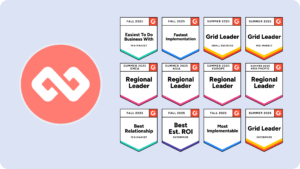Employee disengagement has become a pressing concern for organizations worldwide. Disengaged employees lack motivation, passion, and commitment towards their work, leading to decreased productivity and overall performance. It also affects your succession planning and retention so it’s worth understanding it and getting ahead of the problems that employee disengagement will inevitably cause.
Let’s get to it.
The Potential Impact of Disengagement on Organizational Performance
When employees feel disconnected from their work, it creates a ripple effect that can have far-reaching consequences for the entire organization. Productivity declines, deadlines are missed, and quality suffers. Moreover, disengagement can negatively impact team dynamics and collaboration. With disengaged employees, innovation and creativity are also stifled, hindering the organization’s ability to adapt and thrive in an ever-changing market.
Let’s dive a bit deeper.
Declining Effectiveness and Quality of Work
When employees are disengaged, their motivation to perform at their best diminishes. They may lack the drive and enthusiasm to go above and beyond their job responsibilities, leading to a decline in productivity. Tasks that used to be completed efficiently and effectively may now take longer.
Missed deadlines become a common occurrence in an environment where disengagement prevails. When employees are not fully invested in their work, they may struggle to meet project timelines and deliverables. This can have a domino effect on the organization, causing delays in other departments and negatively impacting overall performance.
Declining Efficiency and Productivity
Without a sense of pride and ownership in their work, employees may become complacent and less attentive to maintaining high standards. This can result in a decrease in the quality of products or services your organization offers, leading to dissatisfied customers and potential reputational damage.
Team dynamics and collaboration are also significantly affected by employee disengagement. When employees are disconnected from their work, they are less likely to actively participate in team discussions, share ideas, and contribute to problem-solving. This lack of engagement can hinder the overall effectiveness of teams, as valuable perspectives and insights may be overlooked.
Declining Customer Satisfaction and Loyalty
Employee disengagement not only affects internal operations but also has a direct impact on customer satisfaction and loyalty. When employees are not fully engaged, they may lack the motivation to provide exceptional customer service. This can result in a decline in customer satisfaction levels, as customers may not receive the attention, support, or personalized experience they expect.
Disengaged employees may also fail to understand or care to meet customer needs effectively. They may lack the empathy and attentiveness required to truly understand customer pain points and provide them with solutions. This can lead to frustrated customers who may seek alternatives, resulting in decreased customer loyalty and loss of business.
Decline In The Organization’s Agility and Creativity
Disengaged employees are less likely to embrace innovation and creativity. They may resist change and be hesitant to explore new ideas or approaches. This can be detrimental to an organization’s ability to stay competitive and adapt to evolving market trends. Organizations need employees who are willing to think outside the box and embrace innovation to drive growth and success – having disengaged employees doesn’t help that.
Identifying the Signs of Employee Disengagement
It’s not always easy to spot disengaged employees, as they may try to conceal their lack of motivation. Nevertheless, there are telltale signs that can indicate a disconnect between employees and their work.
Worsening Performance and Productivity
When an employee who was once enthusiastic and highly efficient starts missing deadlines and producing subpar work, it may be an indicator of disengagement. Disengaged employees make more mistakes, overlook details, or show a lack of thoroughness in their work. They also start missing deadlines or turning in bare minimum work.
Increased Absenteeism
This is one of the most visible, glaring red flags signaling employee disengagement within an organization. When employees feel disconnected or disinterested in their work, they are more likely to seek refuge in the form of frequent absences as they often lack the motivation to come to work regularly to avoid the environment or doing specific tasks.
This behavior may manifest as unscheduled sick days, unexplained leaves, or an uptick in personal time off. The rise in absenteeism not only reflects a diminished commitment to professional responsibilities but also underscores a deeper issue of waning motivation and job satisfaction.
General Apathy and Lack of Enthusiasm
Another red flag is decreased enthusiasm and a general apathy towards work-related initiatives. They may also withdraw from team activities and social interactions, preferring to keep to themselves. Disengaged employees will also refrain from providing suggestions, feedback, or participating in decision-making processes. They will often refuse to join anything social as well.
Lack of Inititative
Disengaged employees often show a reluctance to go beyond the basic requirements of their roles, displaying a lack of proactivity and enthusiasm for contributing innovative ideas or solutions. When employees disengage, they may refrain from taking on additional responsibilities or seizing opportunities for professional growth. The diminishing sense of ownership and initiative can create a stagnating effect, impacting not only individual performance but also the overall dynamism and progress of the team.
Negative Attitude
When individuals become disengaged, a shift in their overall outlook becomes evident, marked by increased pessimism, complaints, and a general lack of enthusiasm for their work. This negativity can permeate the workplace, affecting team morale and collaborative efforts. Disengaged employees may become critical of management decisions, colleagues, and organizational goals, fostering an atmosphere that is detrimental to productivity and a positive work environment.
Lack of Interest in Opportunities within the Organization
A conspicuous lack of interest in internal opportunities serves as a clear manifestation of employee disengagement. They may exhibit a reluctance to explore or pursue advancement within the company, showing little enthusiasm for professional development (e.g. training or skill development) or career growth.
This lack of interest in internal opportunities can be reflective of a broader disconnection from the organization’s goals and a diminished sense of purpose. Engaged employees typically seek ways to contribute meaningfully to their work and advance their careers within the company, whereas disengaged individuals may display apathy towards such prospects.
Resistance to Change
Resistance to change within an organization often signals employee disengagement as individuals become entrenched in their comfort zones and hesitant to embrace new initiatives. Disengaged employees may exhibit a reluctance to adapt to evolving processes, technologies, or organizational shifts, showcasing a lack of investment in the future direction of the company. This resistance is indicative of a disconnect between employees and the broader strategic vision, hindering innovation and impeding the organization’s ability to remain agile in a dynamic business environment.
Increasing Turnover
If there is a pattern of employees leaving a particular team, department, or business unit, it could be a sign of disengagement issues. When employees’ commitment to the company wanes, the likelihood of seeking alternative employment rises. High turnover rates indicate a failure to retain valuable talent, as disengaged employees often feel undervalued, uninspired, or unconnected to the organization’s mission. This exodus can lead to a loss of institutional knowledge, increased recruitment costs, and disruptions in team dynamics.
Understanding the Causes of Employee Disengagement
It’s crucial to identify the root causes of employee disengagement before implementing strategies for improvement. So let’s go through some of the most common causes.
Not Having a Sense of Purpose
When employees are not aware of how their individual tasks fit into the overall goals and objectives of the organization, they may struggle to find meaning in their work. This leads to disengagement and a decrease in productivity.
When employees feel disconnected from the broader mission and objectives of the company, their work may become a mere series of tasks devoid of intrinsic meaning. Without a clear understanding of how their contributions align with the organization’s purpose, individuals may struggle to find motivation and enthusiasm for their roles. This absence of purpose not only impacts individual job satisfaction but can also have ripple effects on team dynamics and overall productivity.
Poor Leadership
When employees have leaders who are micromanagers, ineffective, unsupportive, or inconsistent in their decision-making, employees feel disillusioned and disconnected from their work. When leaders fail to provide clear direction, effective communication, and a positive work culture, employees feel unsupported, undervalued, or unsure of their roles. Inadequate leadership can manifest in a lack of recognition, insufficient feedback, and a failure to create a motivating and inclusive environment.
Disengaged employees perceive a disconnect between their efforts and the overall vision of the company, leading to a sense of disillusionment and decreased morale. Addressing poor leadership involves not only developing the necessary skills in leaders but also fostering a culture of trust, open communication, and genuine concern for the well-being and development of the team.
Unclear Expectations and Lack of Feedback
Clear expectations and regular feedback are essential for employees to understand their roles and responsibilities, as well as to track their progress and make necessary improvements. When employees are unsure about what is expected of them or receive inconsistent feedback, confusion and frustration set in and they become demotivated and disengaged.
Additionally, the absence of regular feedback on their work can leave employees feeling undervalued and uncertain about their contributions. Disengagement often flourishes in an environment where employees perceive a lack of support or acknowledgment for their efforts.
Limited Growth Opportunities
When employees feel stagnant, like there is no room for advancement or development in their current position, they lose interest and become disengaged. After all, why bother working hard without any potential professional or personal reward?
When employees perceive a lack of avenues for professional development, career advancement, or skill enhancement, their motivation to invest in their roles diminishes. It can lead to feelings of stagnation and frustration, prompting talented individuals to disengage from their work. Employees who sense a dearth of opportunities become demotivated, disenchanted, and may even start exploring external options for career advancement.
Lack of Recognition
The absence of recognition is a compelling cause of employee disengagement as it strikes at the heart of an individual’s intrinsic motivation and sense of value within the organization. When employees’ contributions go unnoticed or unacknowledged, a profound demotivation can set in, leading to a disconnection from the work and a diminished commitment to going above and beyond.
Recognition is a fundamental human need in the workplace, and its absence can lead to feelings of frustration, demotivation, and a sense of undervaluation. When employees believe that their efforts are not recognized or rewarded, they start to question the value of their work and lose motivation to contribute and excel.
Poor Communication
Poor communication serves as a potent cause of employee disengagement due to the fundamental role it plays in shaping the work environment. When employees are left in the dark about important decisions, changes, or updates, they feel disconnected and uninvolved, leading them to check out and disengage. This lack of transparency also breeds uncertainty and erodes trust among the workforce.
Employees may feel undervalued or unimportant or that their opinions do not matter when essential information is withheld. The absence of clear communication channels can hinder their ability to seek guidance or share feedback. Disengagement thrives in an atmosphere where employees feel isolated or uninformed, leading to decreased morale, lower job satisfaction, and a diminished sense of purpose.
Lack of Collaboration Opportunities
The lack of collaboration opportunities can significantly contribute to employee disengagement by fostering an environment of isolation and hindering the sense of teamwork and shared purpose. When employees are denied the chance to collaborate with colleagues, share ideas, and contribute collectively to projects, they may feel disconnected from the broader organizational objectives. Collaboration not only enhances creativity and problem-solving but also creates a sense of camaraderie and shared achievement. In the absence of collaborative opportunities, employees may experience a lack of motivation, a diminished sense of belonging, and a reduced understanding of their impact on the organization.
Lack of Work-Life Balance
The lack of work-life balance stands as a significant cause of employee disengagement as it places strain on an individual’s overall well-being and satisfaction. When employees are constantly overwhelmed with work demands and have little time for personal life and self-care, they experience burnout and start resenting their workplace and the organization as a whole.
This imbalance can lead to increased stress, fatigue, and a sense of dissatisfaction that seeps into the professional realm, diminishing motivation and commitment. Disengaged employees often experience a decreased sense of fulfillment in their roles, impacting their productivity and overall job satisfaction. Organizations that fail to prioritize work-life balance risk not only the physical and mental well-being of their workforce but also the long-term engagement and loyalty of their employees.
The Role of Leadership in Dealing with Employee Disengagement
Leaders and managers play a vital role in addressing and resolving employee disengagement. They must create an environment that fosters engagement and helps employees reconnect with their work.
Effective leadership involves building strong relationships with team members, providing regular feedback and recognition, and encouraging open communication. It is also important for leaders to set a positive example by demonstrating passion and enthusiasm for their own work.
Furthermore, leaders should prioritize employee development and growth by offering training opportunities, mentoring programs, and the chance to take on new and challenging projects. When employees feel supported in their professional development, they are more likely to stay engaged and committed.
Integrating automated performance management tools can also streamline these processes, making it easier for leaders to offer consistent feedback and personalized development plans.
Mentoring Your Leaders
Improving leadership practices is paramount to preventing and reversing employee disengagement, creating a foundation for a thriving and productive work environment. And one way to do it is by supporting the continuous development of your organization’s leaders by providing them with mentorship opportunities.
A well-mentored leadership team is more likely to be equipped with the necessary skills to foster open communication, recognize and address employee concerns, and create an inclusive work environment. They understand the importance of acknowledging and appreciating their team members, providing growth opportunities, and maintaining a healthy work-life balance—all critical elements in combating disengagement. The lessons they learn from being mentored by other leaders allows them to gain insights into people’s needs and aspirations, enabling them to tailor their leadership approach, boost morale, and create a workplace that aligns with the diverse talents and goals of the workforce.
Moreover, mentoring your leaders will allow your organization to instill a proactive approach to identifying and addressing signs of employee disengagement. Mentored leaders are better prepared to recognize early indicators of discontent, implement strategies for resolution, and create a culture of trust and collaboration. This proactive stance not only helps mitigate disengagement but also contributes to a positive organizational climate where employees feel heard, valued, and motivated to contribute their best efforts.
Encouraging Your People To Build Relationships With Organization Leaders
Establishing meaningful connections between your people and the organization’s leaders provides employees with direct access to leadership insights, guidance, and opportunities for professional growth. When employees feel supported and valued through mentorship, they are more likely to become actively engaged in their roles. These relationships foster a sense of connection and trust, breaking down barriers between hierarchical levels and promoting a more inclusive workplace culture. Employees who feel heard and understood by organizational leaders are more likely to voice concerns, share innovative ideas, and actively contribute to the organization’s success, mitigating factors that contribute to disengagement.
Mentoring relationships with leaders can also serve as a conduit for aligning individual aspirations with organizational goals. As employees gain exposure to the broader vision and strategies of the organization through mentorship, they can better understand their roles in the larger context. This clarity not only increases job satisfaction but also helps employees see the impact of their contributions, fostering a sense of purpose that is instrumental in combatting disengagement.
A comprehensive hiring and onboarding process also provides a prime opportunity for employees to feel included and informed about the company’s values and mission right from the start. This foundational step helps strengthen essential relationships and promotes constant engagement and alignment throughout the organization, ensuring that every employee understands their role and the broader goals of the organization, fostering a connected and motivated workforce.
Strategies for Mitigating Disengagement in the Workplace
Addressing employee disengagement requires a multi-faceted approach that focuses on both individual and organizational aspects. Here are some strategies to consider:
- Improve communication: Regularly update employees on company goals and initiatives, and provide feedback and recognition to foster a sense of connectedness and purpose.
- Provide growth opportunities: Invest in training and development programs, mentorship programs, and career advancement opportunities to show employees that their growth is important.
- Foster a positive work environment: Encourage collaboration, create a supportive culture, and promote work-life balance to enhance employee satisfaction and engagement.
- Recognize and reward achievements: Celebrate employee accomplishments and provide incentives to reinforce positive behaviors and boost morale.
- Encourage employee involvement: Empower employees by involving them in decision-making processes, seeking their input, and valuing their opinions.
Continue Learning: A Comprehensive Guide to Employee Engagement
Conclusion
Employee disengagement is a pressing issue with severe implications for organizational success. By understanding the signs, causes, and impact of disengagement, leaders can navigate the disconnect and prioritize and implement employee engagement strategies to foster a positive and productive work environment that ultimately drives success.
Ready to transform your organization’s mentoring approach and combat employee disengagement? Discover how Mentorloop can elevate your organizational culture with a mentoring program that empowers your people to make life-changing connections at scale.
Don’t wait to make a change—Book a Mentorloop demo today and start your journey towards disengagement in your workforce.
And to ensure your HR processes are streamlined to support these initiatives, explore how Rippling’s all-in-one HR platform can seamlessly integrate with your daily operations, enhancing the effectiveness of your engagement strategies.


![[Webinar Kit] Turnover Threat into Talent Triumph: Designing a mentoring program that boosts employee engagement Learn how to design a high-impact mentoring program that helps you achieve your employee engagement goals.](https://no-cache.hubspot.com/cta/default/4058869/interactive-189625368503.png)



